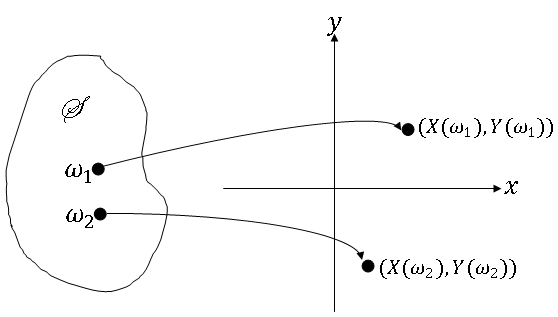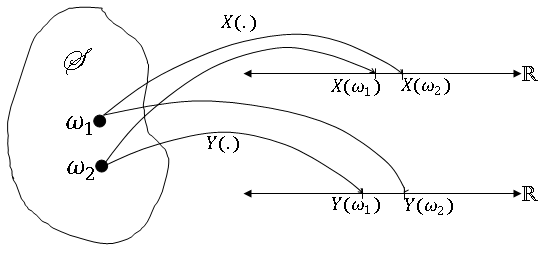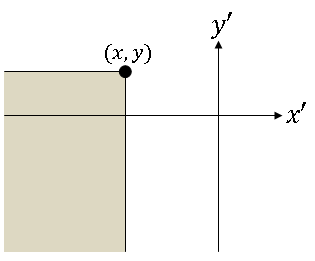(New page: Category:ECE600 Category:Lecture notes <center><font size= 4> '''Random Variables and Signals''' </font size> <font size= 3> Topic 10: Two Random Variables: Joint Distribution</f...) |
|||
| Line 30: | Line 30: | ||
In order for X and Y to be a valid random variable pair, we will need to consider regions D ⊂ '''R'''<math>^2</math>.<br/> | In order for X and Y to be a valid random variable pair, we will need to consider regions D ⊂ '''R'''<math>^2</math>.<br/> | ||
| − | <center><math>B(\ | + | <center><math>B(\mathbb{R}^2) = \sigma (\{\mbox{all open rectangles in }\mathbb{R}^2\})</math></center> |
We need {(X,Y) ∈ O} ∈ ''F'' for any open rectangle O ⊂ '''R'''<math>^2</math>, then {(X,Y) ∈ D} ∈ ''F'' ∀D ∈ B('''R'''<math>^2</math>).<br/> | We need {(X,Y) ∈ O} ∈ ''F'' for any open rectangle O ⊂ '''R'''<math>^2</math>, then {(X,Y) ∈ D} ∈ ''F'' ∀D ∈ B('''R'''<math>^2</math>).<br/> | ||
| Line 38: | Line 38: | ||
&X^{-1}(A) \in \mathcal F \\ | &X^{-1}(A) \in \mathcal F \\ | ||
&Y^{-1}(B) \in \mathcal F \\ | &Y^{-1}(B) \in \mathcal F \\ | ||
| − | &\forall A,B\in B(\ | + | &\forall A,B\in B(\mathbb R) |
\end{align}</math></center> | \end{align}</math></center> | ||
So, <br/> | So, <br/> | ||
Revision as of 14:21, 24 October 2013
Random Variables and Signals
Topic 10: Two Random Variables: Joint Distribution
Two Random Variables
We have been considering a single random variable X and introduces the pdf f$ _X $, and pmf p$ _X $, conditional pdf f$ _X $(x|M), the conditional pmf p$ _X $(x|M), pdf f$ _Y $ or pmf p$ _Y $ when Y = g(X), expectation E[g(X)], conditional expectation E[g(X)|M], and characteristic function $ \Phi_X $. We will now define similar tools for the case of two random variables X and Y.
How do we define two random variables X,Y on a probability space (S,F,P)?
So two random variables can be viewed aw a mapping from S to R$ ^2 $, and (X,Y) is an ordered pair in R$ ^2 $. Note that we could draw the picture this way:
but this would not capture the joint behavior or X and Y. Note also that if X and Y are defined on two different probability spaces, those two spaces can be combined to create (S,F,P).
In order for X and Y to be a valid random variable pair, we will need to consider regions D ⊂ R$ ^2 $.
We need {(X,Y) ∈ O} ∈ F for any open rectangle O ⊂ R$ ^2 $, then {(X,Y) ∈ D} ∈ F ∀D ∈ B(R$ ^2 $).
But (X($ \omega $),Y($ \omega $)) ∈ O if X($ \omega $ ∈ A and Y($ \omega $ ∈ B for some A, B ∈ B(R), so {(X,Y) ∈ 0} = X$ ^{-1} $(A) ∩ Y$ ^{-1} $(B)
If X and Y are valid random variables then
So,
So how do we find P((X,Y) ∈ D) for D ∈ B(R$ ^2 $)?
We will use joint cdfs, pdfs, and pmfs.
Joint Cumulative Distribution Function
Knowledge of F$ _X $(x) and F$ _Y $(y) alone will not be sufficient to compute P((X,Y) ∈ D) ∀D ∈ B(R$ ^2 $), in general.
Definition $ \qquad $ The joint cumulative distribution function of random variables X,Y defined on (S,F,P) is F$ _{XY} $(x,y) ≡ P({X ≤ x}{Y ≤ y}) for x,y ∈ R.
Note that in this case, D ≡ D$ _{XY} $ = {(x',y') ∈ R$ ^2 $: x' ≤ x, y' ≤ y}
Properties of F$ _{XY} $:




